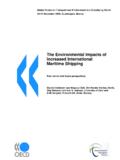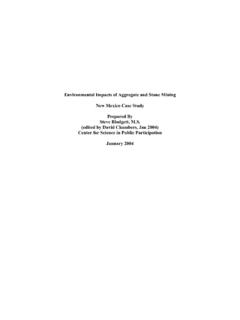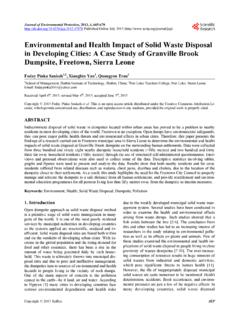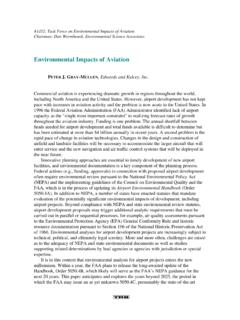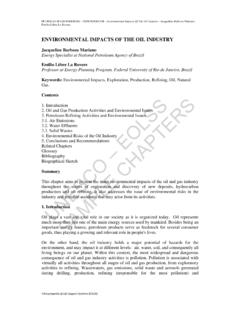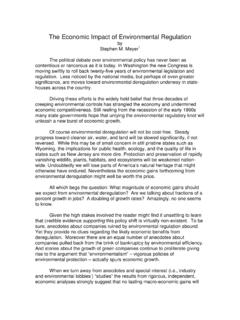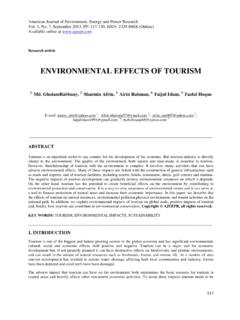Transcription of Environmental impacts of tourism - CIHEAM
1 Environmental impacts of tourismSunlu D. (ed.), Grassini L. (ed.). Local resources and global trades: Environments and agriculture in the MediterraneanregionBari : CIHEAMO ptions M diterran ennes : S rie A. S minaires M diterran ens; n. 572003pages 263-270 Article available on line / Article disponible en ligne l adresse :--------------------------------------- ---------------------------------------- ---------------------------------------- ---------------------------------------- ----------- ---------------------------------------- ---------------------------------------- ---------------------------------------- ---------------------------------------- ----------To cite this article / Pour citer cet article--------------------------------- ---------------------------------------- ---------------------------------------- ---------------------------------------- -----------------Sunlu U.
2 Environmental impacts of tourism . In : Camarda D. (ed.), Grassini L. (ed.). Localresources and global trades: Environments and agriculture in the Mediterranean region. Bari : CIHEAM ,2003. p. 263-270 (Options M diterran ennes : S rie A. S minaires M diterran ens; n. 57)------------------------------------- ---------------------------------------- ---------------------------------------- ---------------------------------------- ------------- impacts OF TOURISMUgur SunluEge University, Faculty of Fisheries, Dept. of Hydrobiology, Bornova/Izmir, TurkeyABSTRACTThe quality of the environment, both natural and man-made, is essential to tourism .
3 However, the relationship of tourism with the environment is complex. It involves many activities that can have adverse Environmental effects. Many of these impacts are linked with the construction of general infrastructure such as roads and airports, and of tourism facilities, including resorts, hotels, restaurants, shops, golf courses and marinas. The negative impacts of tourism development can gradually destroy Environmental resources on which it depends. On the other hand, tourism has the potential to create beneficial effects on the environment by contributing to Environmental protection and conservation.
4 It is a way to raise awareness of Environmental values and it can serve as a tool to finance protection of natural areas and increase their economic importance. In this paper, we describe that the effects of tourism on natural resources, Environmental pollution and physical environment. In addition, we explain Environmental impacts of tourism on global scale, industrial impacts on tourism and, finally, how tourism can contribute to Environmental words: tourism , Environmental impacts , INTRODUCTIONT ourism especially, marine and coastal tourism is one the fastest growing areas within the world's largest industry.
5 Yet despite increased awareness of the economic and Environmental significance of tourism , it is only in recent years, scientific researches have emerged (Hall, 2001).This paper provides a review of some tourism literature, which focuses, in particular on Environmental impacts of impacts from tourism occur when the level of visitor use is greater than the environment's ability to cope with this use within acceptable limits of change. Uncontrolled conventional tourism poses potential threats to many natural areas around the world. It can put enormous pressure on an area and lead to impacts such as soil erosion, increased pollution, discharges into the sea, natural habitat loss, increased pressure on endangered species and heightened vulnerability to forest fires.
6 It often puts a strain on water resources, and it can force local populations to compete for the use of critical resources. 2. DEPLETION OF NATURAL RESOURCEST ourism development can put pressure on natural resources when it increases consumption in areas where resources are already scarce. Water ResourcesWater, and especially fresh water, is one of the most critical natural resources. The tourism industry generally overuses water resources for hotels, swimming pools, golf courses and personal use of water by tourists. This can result in water shortages and degradation of water supplies, as well as generating a greater volume of waste water.
7 In dry and hot regions like the Mediterranean, the issue of water scarcity is of particular concern. Because of the hot climate and the tendency of tourists to consume more water when on holiday than they do at home, the amount used can run up to 440 liters a day. This is almost double what the inhabitants of an average Spanish city use (UNEP, 1999).264 Golf course maintenance can also deplete fresh water resources. In recent years golf tourism has increased in popularity and the number of golf courses has grown rapidly. Golf courses require an enormous amount of water every day and as with other causes of excessive extraction of water, this can result in water scarcity.
8 If the water comes from wells, overpumping can cause saline intrusion into groundwater. Golf resorts are more and more often situated in or near protected areas or areas where resources are limited. Local Resources tourism can create great pressure on local resources like energy, food, and other raw materials that may already be in short supply. Greater extraction and transport of these resources exacerbates physical impacts associated with their exploitation. Because of the seasonal character of the industry, many destinations have ten times more inhabitants in the high season than in the low season.
9 High demand is placed upon these resources to meet the high expectations tourists often have (proper heating, hot water, etc.). Land Degradation Important land resources include minerals, fossil fuels, fertile soil, forests, wetland and wildlife. Increased construction of tourism and recreational facilities has increased pressure on these resources and on scenic landscapes. Direct impact on natural resources, both renewable and non-renewable, in the provision of tourist facilities can be caused by the use of land for accommodation and other infrastructure provision, and the use of building often suffer negative impacts of tourism in the form of deforestation caused by fuel wood collection and land clearing.
10 For example, one trekking tourist in Nepal and area already suffering the effects of deforestation can use four to five kilograms of wood a day (UNEP, 1999).3. POLLUTION tourism can cause the same forms of pollution as any other industry: air emissions, noise, solid waste and littering, releases of sewage, oil and chemicals, even architectural/visual Air Pollution and Noise Transport by air, road, and rail is continuously increasing in response to the rising number of tourists and their greater mobility. The International Civil Aviation Organization reported that the number of international air passengers worldwide rose from 88 million in 1972 to 344 million in 1994.




